Physical Address
304 North Cardinal St.
Dorchester Center, MA 02124
Ultrasound should be the first imaging modality used in the evaluation of the patients with potential disease of the biliary tree.
Awareness of various scanning techniques and use of harmonic and compound imaging improve visualization of various diseases affecting the biliary tree.
Stones in the intrahepatic and extrahepatic biliary tree can be easily overlooked; familiarity with their appearance and a high index of suspicious improve their detection.
Cholecystitis is a common disease with variable degrees of severity. A high index of suspicion and sensitivity, particularly to distention and hyperemia of the gallbladder, allows for improved detection.
The clinical presentation of the patient, particularly pain and signs of inflammation, helps in differentiating the common inflammatory conditions of the biliary tree and gallbladder from the rarer malignancies which they may mimic.
Sonographic evaluation of the biliary tract is one of the most appropriate and efficacious uses of the ultrasound examination. The cystic nature of both the gallbladder and the bile ducts, particularly when dilated, provides an inherently high-contrast resolution in comparison to the adjacent tissues. The excellent spatial resolution of sonography, and the acoustic window provided by the liver allow for a high-quality examination in most patients. Currently, sonography remains the imaging modality of choice for the detection of gallstones, assessment of acute right upper quadrant (RUQ) pain, and initial evaluation of the patient with jaundice or elevated liver function tests. In conjunction with magnetic resonance imaging (MRI), magnetic resonance cholangiopanreatography (MRCP), and contrast-enhanced computed tomography (CT), sonography also plays a key role in the multimodality evaluation of more complex biliary problems, such as the diagnosis and staging of hilar cholangiocarcinoma. The recent development of contrast-enhanced sonography for detection of hepatic masses further broadens this role. From the smallest ultrasound departments operating in remote geographic areas to the largest tertiary institutions, no other anatomic location in the body is better studied with sonography than the biliary tract.
An understanding of the normal location of the bile ducts and common anatomic variations is important in staging malignancies and directing intervention. In biliary terminology, proximal denotes the portion of the biliary tree that is in relative proximity to the liver and hepatocytes, whereas distal refers to the caudal end closer to the bowel. The term branching order applies to the level of division of the bile ducts starting from the common hepatic duct (CHD); first-order branches are the right and left hepatic ducts, second-order branches are their respective divisions (also known as secondary biliary radicles ), and so on. Central specifies proximity to the porta hepatis, whereas peripheral refers to the higher-order branches of the intrahepatic biliary tree extending well into the hepatic parenchyma. Knowledge of Couinaud functional anatomy of the liver is also vital in description of the intrahepatic biliary abnormalities (see Chapter 4 ).
The intrahepatic ducts are not in a fixed relation to the portal veins within the portal triads and can be anterior or posterior to the vein or even tortuous about the vein. The right and left hepatic ducts, that is, the first-order branches of the CHD, are routinely seen on sonography, and normal second-order branches may be visualized ( Fig. 6.1 ). Spectral and color Doppler ultrasound are often needed to distinguish hepatic arteries from ducts, though ducts tend to be straight whereas arteries are tortuous. In our experience, visualization of third-order or higher-order branches is often an abnormal finding and requires a search for the cause of dilation. Most of the right and left hepatic ducts are extrahepatic and, along with the CHD, form the hilar or central portion of the biliary tree at the porta hepatis. This is the most common location for cholangiocarcinoma. The normal diameter of the first-order and higher-order branches of the CHD has been suggested to be 2 mm or less, and no more than 40% of the diameter of the adjacent portal vein.
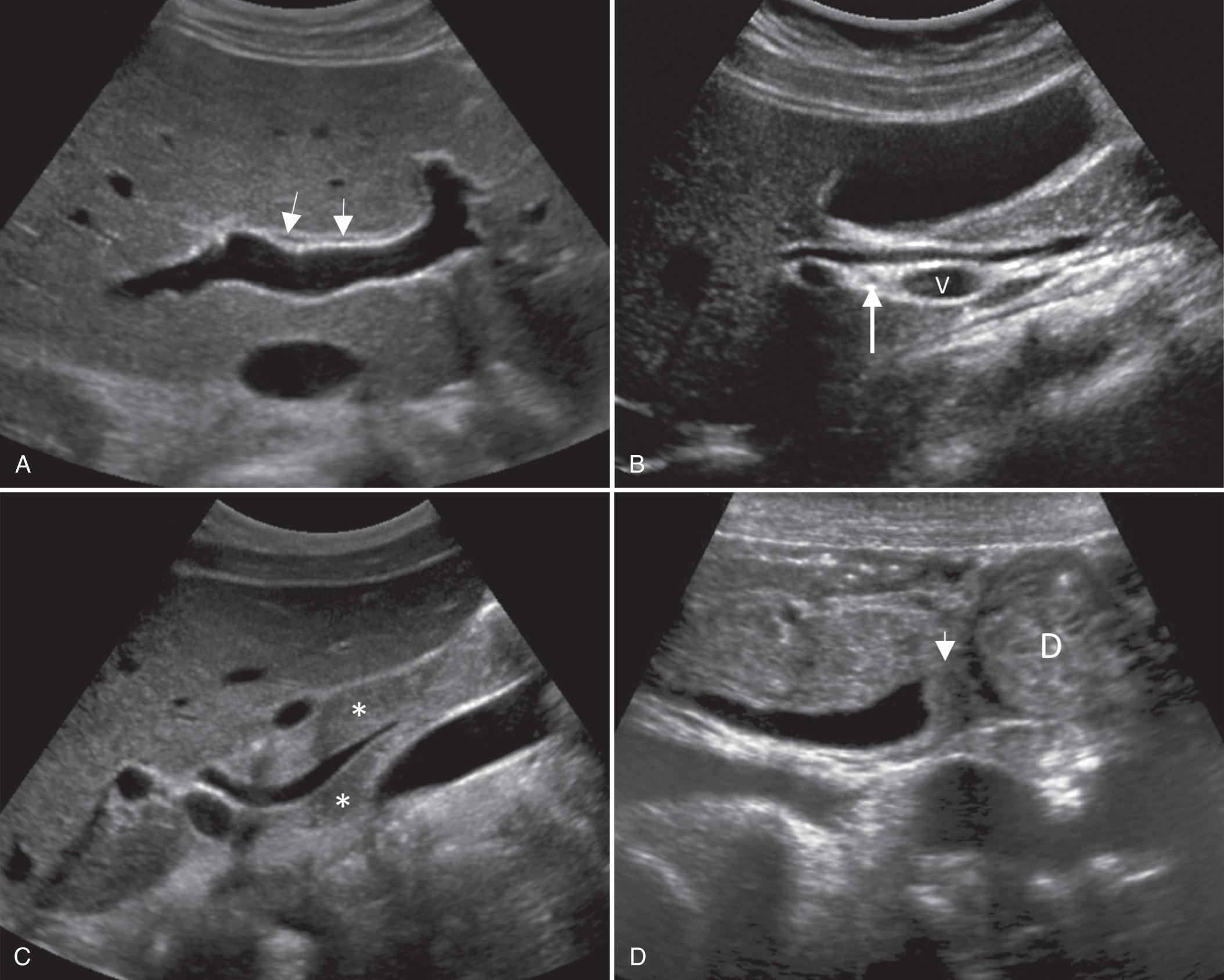
The most common biliary branching pattern occurs in 56% to 58% of the population ( Figs. 6.2 and 6.3 ). On the right side, the right hepatic duct forms from the right anterior and right posterior branches, draining the anterior (segments 5 and 8) and posterior (segments 6 and 7) segments of the right lobe, respectively. On the left side, segment 2 and 3 branches join to the left of the falciform ligament to form the left hepatic duct. This duct becomes extrahepatic in location as it extends to the right of the falciform ligament, where it is joined by ducts of segments 4 and 1.

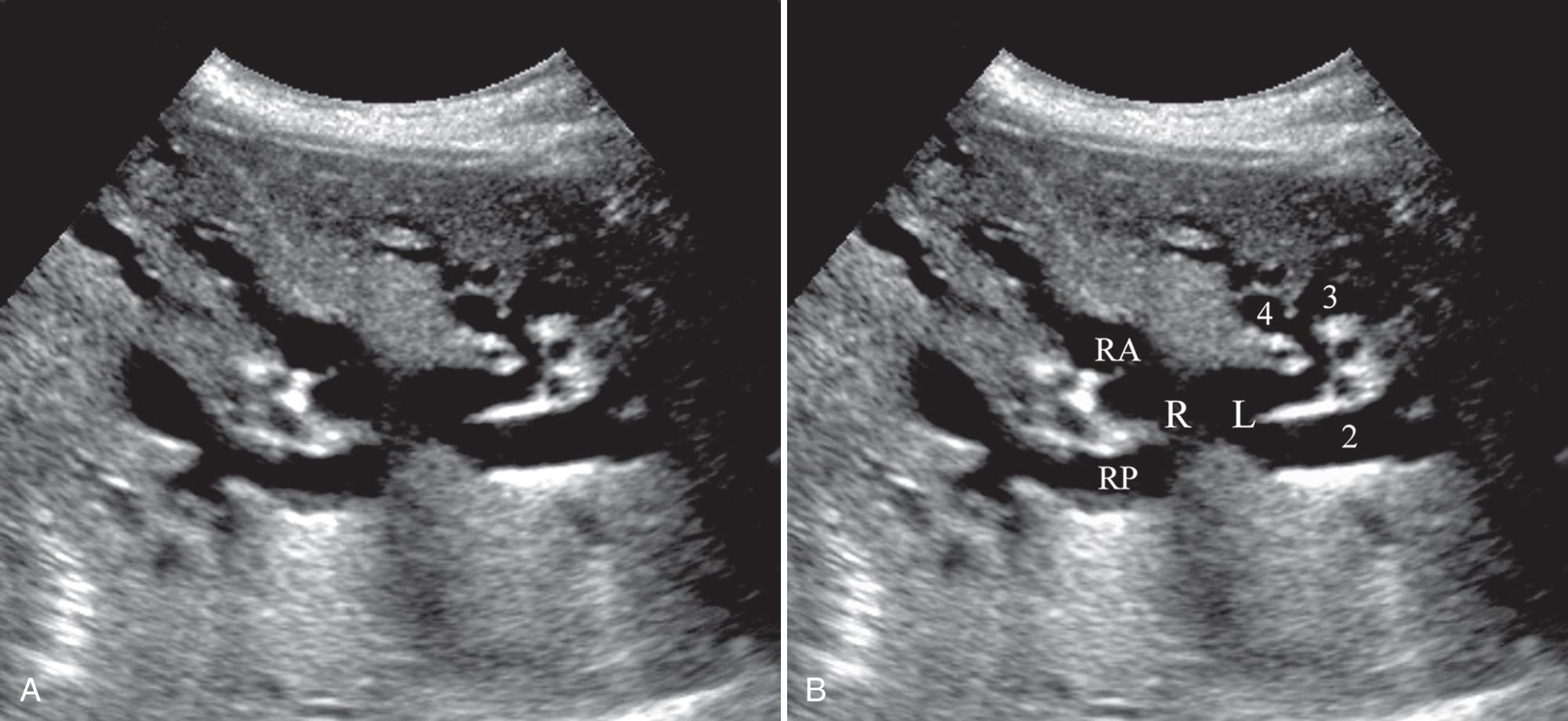
The key to understanding the common normal variants of biliary branching lies in the variability of the site of insertion of the right posterior duct (RPD) (segments 6 and 7). The RPD often extends centrally toward the porta hepatis in a cranial direction. It passes superior and posterior to the right anterior duct (RAD) and then turns caudally, joining the RAD to form the short right hepatic duct (see Fig. 6.2 ). Three other common sites of insertion of the RPD account for the majority of the biliary anatomic variations. If the RPD extends more to the left than usual, it can join the junction of the right and left hepatic ducts (“trifurcation pattern”; ≈8% of normal variants) or the left hepatic duct (≈13%) ( Fig. 6.4 ). If the RPD extends in a caudal-medial direction instead, it can join the CHD or common bile duct (CBD) directly (≈5%). Anomalous drainage of various segmental hepatic ducts directly into the CHDs is less common.
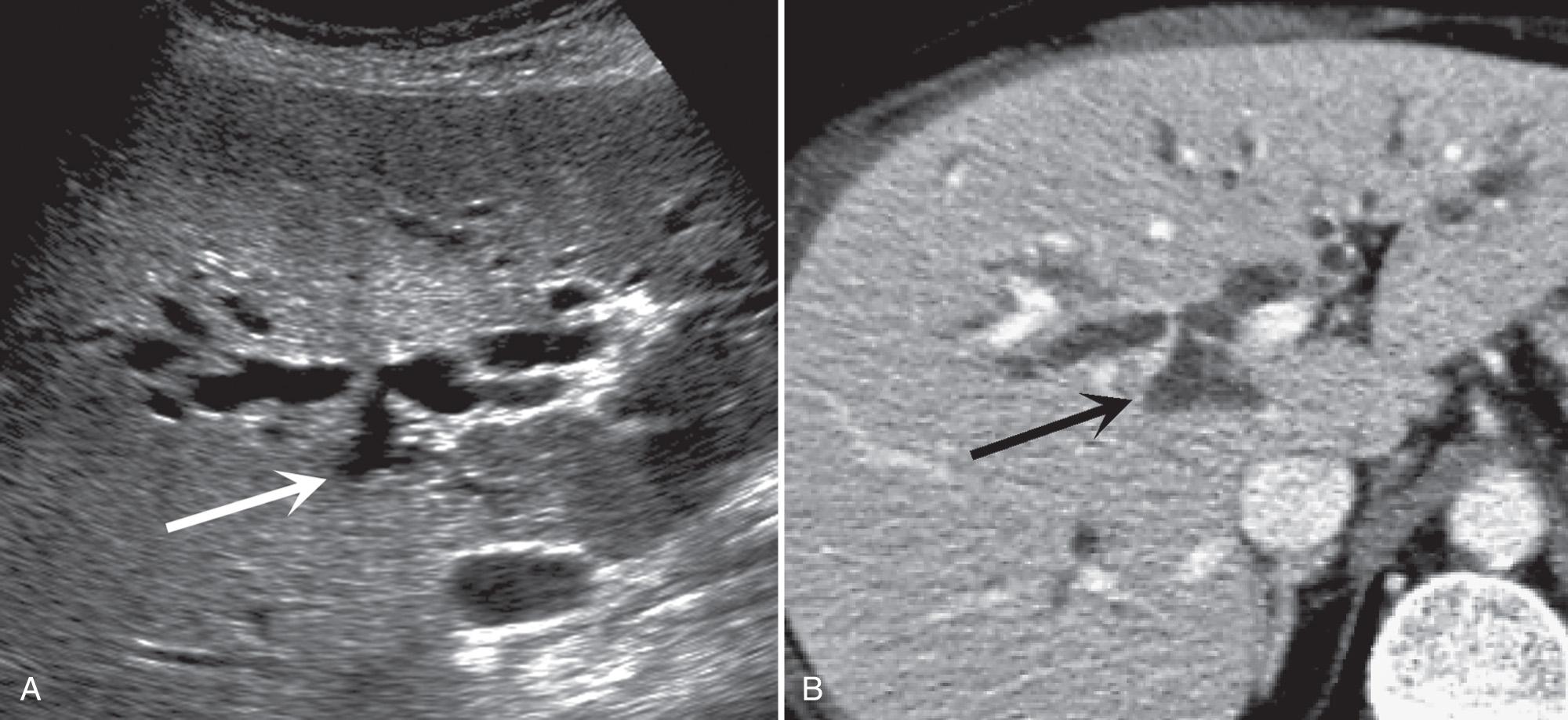
The normal caliber of the CHD/CBD in patients without history of biliary disease is up to 6 mm in most studies (see Fig. 6.1 ). Controversy surrounds whether there is a normal widening of the duct with increasing age. Similarly, studies on an association between cholecystectomy and a large-caliber CBD are inconclusive. Although diameters of up to 10 mm have been recorded in an asymptomatic normal population, the great majority of the diameters are under 7 mm. Therefore a ductal diameter of 7 mm or greater should prompt further investigations, such as correlation with serum levels of cholestatic liver enzymes.
The site of insertion of the cystic duct into the bile duct is quite variable. The cystic duct may join the bile duct along its lateral, posterior, or medial border. It may also run a parallel course to the duct and insert into the lower one-third of the duct, close to the ampulla of Vater. The common bile duct is commonly divided into three segments: the suprapancreatic, retropancreatic, and interstitial/ampullary components. It extends caudally within the hepatoduodenal ligament, lying anterior to the portal vein and to the right of the hepatic artery. It then passes posterior to the first portion of the duodenum and the head of the pancreas, sometimes embedded in the latter. The superior margin of the pancreatic head demarcates the transition between the suprapancreatic and retropancreatic segments of the CBD. It ends in the ampulla of Vater, which is occasionally identified on transabdominal ultrasound with the use of high-frequency linear transducers (see Fig. 6.1D , Video 6.1 ).
Our technique for assessment of the intrahepatic ducts includes a routine scan, as would be performed for liver evaluation, including both sagittal and transverse scans. In addition, we perform a focused scan to assess the porta hepatis, recognizing that its orientation requires an oblique plane to show the length of the right and left hepatic ducts in a single image. For this we utilize a subcostal oblique view with the left edge of the transducer more cephalad than the right edge. The face of the transducer is directed toward the right shoulder. With a full suspended inspiration, a sweep of the transducer from the shoulder to the umbilical region will show the middle hepatic vein, then the long axis of the right and left hepatic ducts at the porta hepatis, followed by the common duct in cross section. By rotating the transducer 90 degrees to this plane, a second suspended inspiration will allow for a long-axis view of the CHD and CBD at the porta hepatis. The visualization of the distal CBD can be a challenge because of overlying duodenal or transverse colonic gas. If the gallbladder is distended, it is often an excellent window through which the distal CBD and pancreatic head can be visualized. With the patient in supine or left lateral decubitus position, the probe may be placed on the gallbladder and angled slightly to the left toward the pancreatic head. Protrusion of the abdomen or examination of the patient in standing upright position also allows the intervening colon to migrate caudally and improves visibility of the pancreatic head.
Harmonic imaging and spatial compound imaging allow for improved contrast between the ducts and adjacent tissues, leading to improved visualization of the duct, its luminal contents, and wall ( Fig. 6.5 ). Furthermore, the conspicuity of stones and their posterior acoustic shadowing is increased. Spatial compounding, while diminishing posterior shadowing, also results in improved contrast to speckle ratio and better depicts intraductal and periductal structures. We advocate routine use of harmonic and compound imaging in the assessment of the biliary tree. Specific scanning techniques for assessment of choledocholithiasis and cholangiocarcinoma are discussed in the appropriate sections.
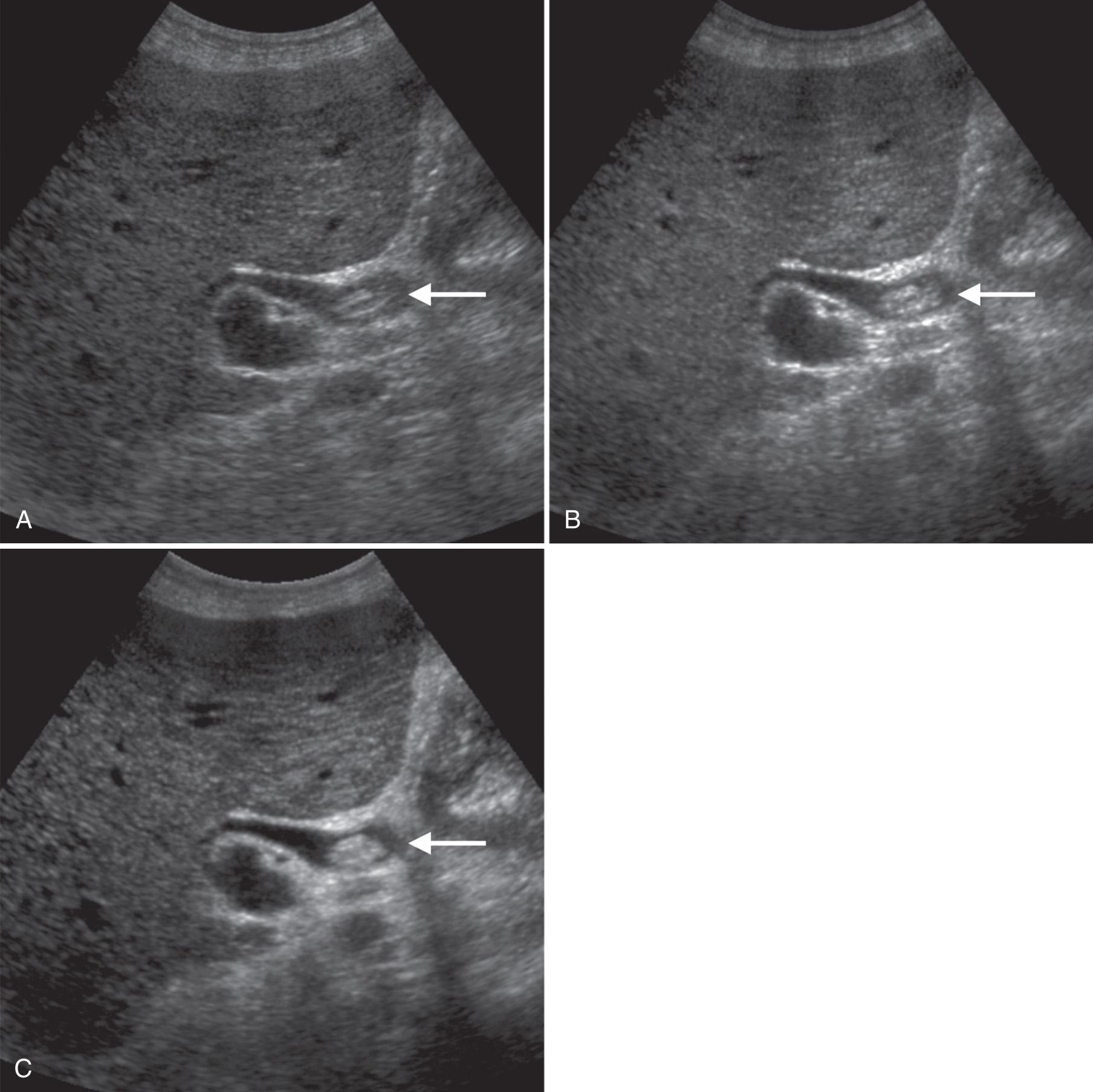
Choledochal cysts represent a heterogeneous group of congenital diseases that may manifest as focal or diffuse cystic dilation of the biliary tree. These cysts occur most often in East Asian populations; the incidence in Japan is 1 in 13,000 versus 1 in 100,000 in Western populations. The female-to-male ratio is 3:1 to 4:1.
Although most patients present early in life, about 20% of choledochal cysts are encountered in adulthood, when sonography is performed for symptoms of gallstone disease. The most widely used classification system divides choledochal cysts into five types ( Figs. 6.6 and 6.7 ). Type I choledochal cysts, a fusiform dilation of the CBD, are the most common (80%) and, along with type IVa, are associated with an abnormally long common channel (>20 mm) between the distal bile duct and the pancreatic duct. This long common channel could allow for reflux of pancreatic juices into the CBD, causing dilation, but this remains controversial. Type II cysts are true diverticula of the bile ducts and are very rare. Type III cysts, the “choledochoceles,” are confined to the intraduodenal portion of the CBD. Type IVa cysts are multiple intrahepatic and extrahepatic biliary dilations, whereas type IVb cysts are confined to the extrahepatic biliary tree. Caroli disease has been classified as a type V cyst, but it has a different embryonic origin and is not a true choledochal cyst.

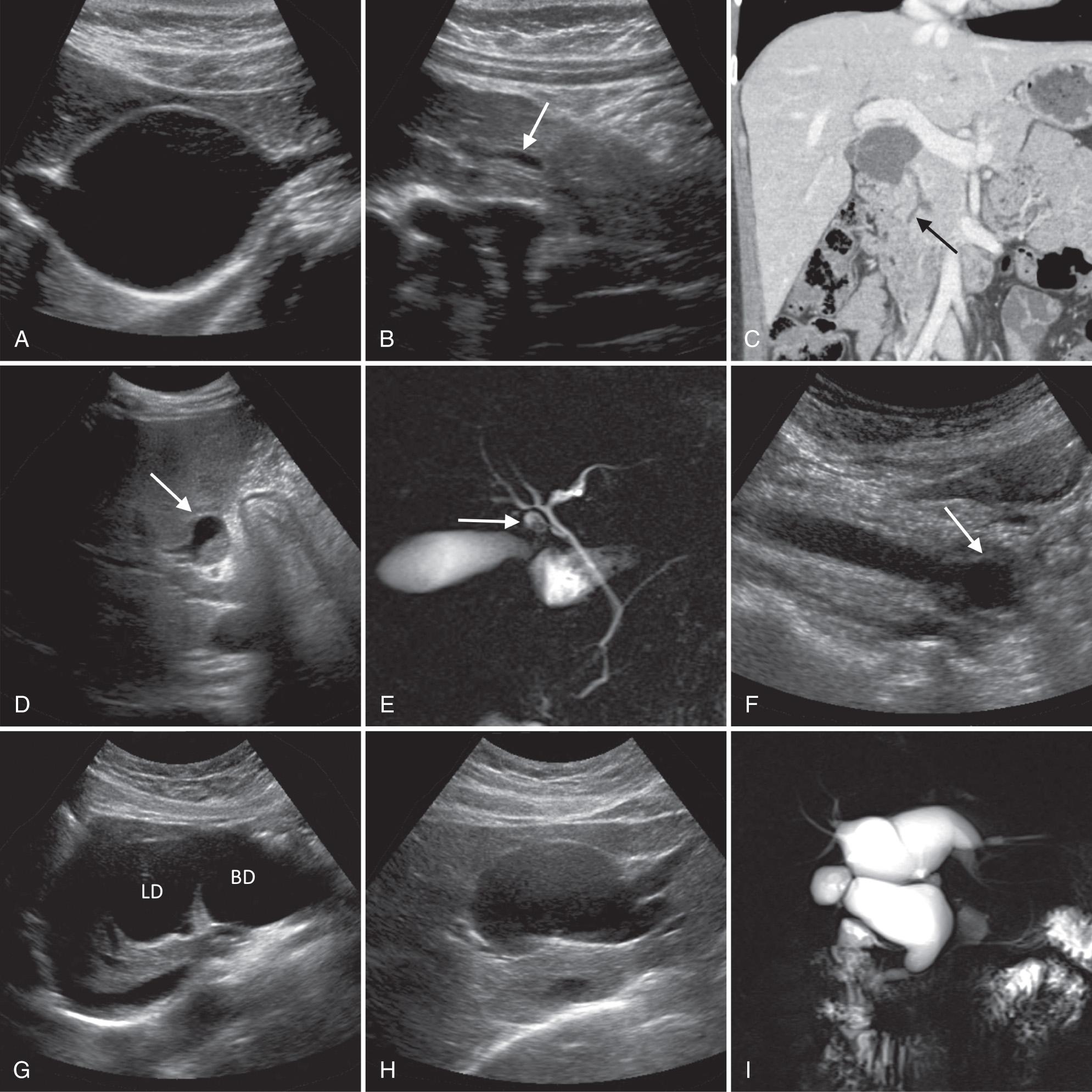
On sonography, a cystic structure is identified that may contain internal sludge, stones, or even solid neoplasm. In some cases the cyst is large enough that its connection to the bile duct is not immediately recognized. Use of various scanning windows and angles allows for demonstration of the relationship of the lesion to the biliary tract, differentiating it from pancreatic pseudocysts or enteric duplication cysts. Biliary scintigraphy, MRCP, and endoscopic retrograde cholangiopancreatography (ERCP) have been used to delineate further the structure of choledochal cysts. ERCP is necessary to ensure that the dilation is not a result of distal neoplasm, especially in the case of type I choledochal cysts (see Fig. 6.7 ). Because there is a risk of cholangiocarcinoma with all choledochal cysts, surgical resection is advocated.
Caroli disease is a rare congenital disease of the intrahepatic biliary tree that results from malformation of the ductal plates, the primordial cells that give rise to the intrahepatic bile ducts. There are two types of Caroli disease: the simple, classic form and the second, more common form, which occurs with congenital hepatic fibrosis. The second form has also been called Caroli syndrome. Caroli disease has been associated with cystic renal disease, most often renal tubular ectasia (medullary sponge kidneys). However, both forms may also be seen in patients with autosomal recessive polycystic kidney disease. Caroli disease affects men and women equally, and more than 80% of patients present before the age of 30 years.
Caroli disease leads to saccular dilation or, less often, fusiform dilation of the intrahepatic biliary tree, resulting in biliary stasis, stone formation, and bouts of cholangitis and sepsis ( Fig. 6.8 ). The disease most often affects the intrahepatic biliary tree diffusely, but it may be focal. The dilated ducts contain stones and sludge. Unlike recurrent pyogenic cholangitis, the ductal contents do not form a cast of the dilated system and thus are more easily identified as ductal contents. Also, small portal vein branches surrounded by dilated bile ducts and bridging echogenic septa traversing the dilated ducts have been described on ultrasound. These correspond to persistent embryonic ductal structures. If associated with congenital hepatic fibrosis, findings of altered hepatic architecture and portal hypertension are also present. Cholangiocarcinoma develops in 7% of patients with Caroli disease.
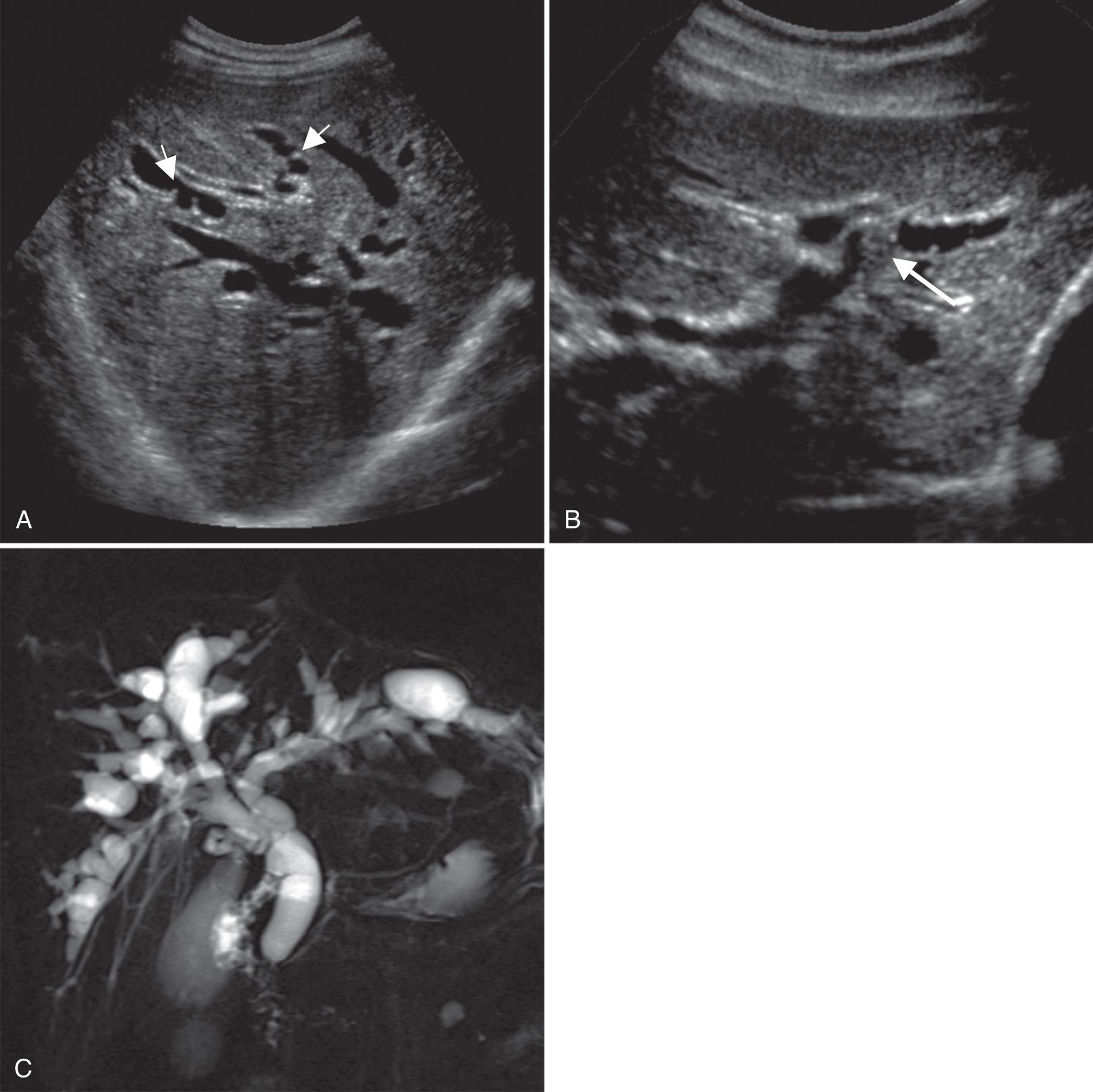
Elevation of cholestatic liver parameters, which may appear clinically as jaundice, is a frequent indication for sonographic examination of the abdomen. The major objective in performing these scans is to determine if the patient has obstruction of the bile ducts, as opposed to a hepatocellular or biliary ductular disease. Sonography is highly sensitive in the detection of dilation of the biliary tree and is therefore an excellent modality for initiation of the imaging investigation ( Fig. 6.9 ). These scans should be performed with knowledge of the patient's clinical condition, especially whether the patient has painless jaundice or has painful jaundice, as seen with acute obstruction or infection affecting the biliary tree.
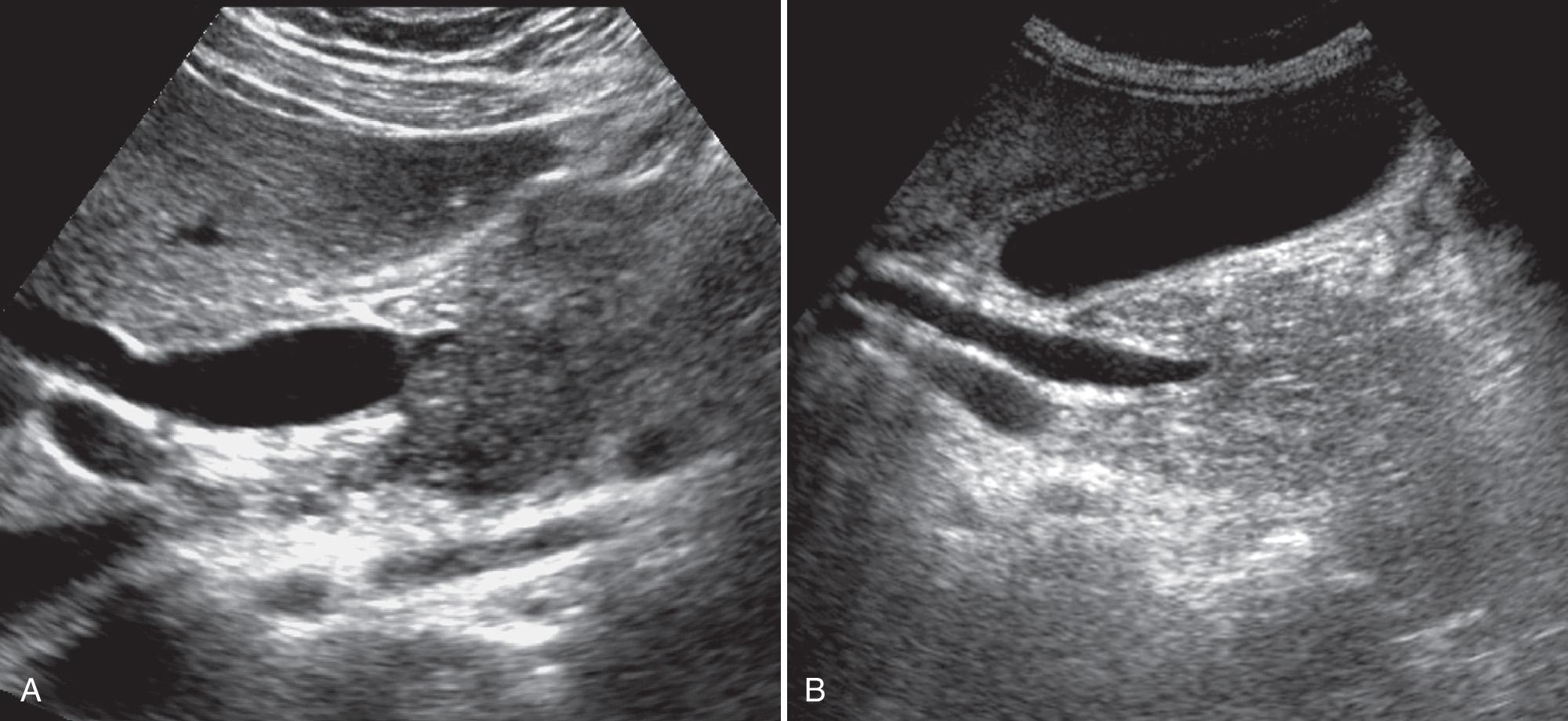
Acute biliary obstruction in the absence of infection may present with RUQ pain and a predominant transaminitis suggesting acute hepatitis rather than cholestasis. Early on, the bile ducts may only be minimally dilated, with imaging findings of a nonspecific hepatitis manifest by edema in the portal triads (echogenic periportal thickening) and fluid accumulation in the gallbladder wall. Therefore in patients with unexplained acute hepatitis, the distal biliary tree should always be examined carefully for choledocholithiasis even if the bile ducts do not appear significantly dilated.
The ultrasound examination should focus on answering the following three questions:
Are the bile ducts or gallbladder dilated?
If dilated, to what level?
What is the cause of the obstruction?
Cholangiocarcinoma
Gallbladder carcinoma
Locally invasive tumors (esp. pancreatic adenocarcinoma)
Ampullary tumors
Metastases
Mirizzi syndrome a
Pancreatitis
Adenopathy
Choledocholithiasis is classified into primary and secondary forms. Primary choledocholithiasis denotes de novo formation of stones, often made of calcium bilirubinate (pigment stones) within the ducts. The etiologic factors are often related to diseases causing strictures or dilation of the bile ducts, leading to stasis, as follows:
Sclerosing cholangitis
Caroli disease
Parasitic infections of the liver (e.g., Clonorchis, Fasciola, Ascaris )
Chronic hemolytic diseases, such as sickle cell disease
Prior biliary surgery, such as biliary-enteric anastomoses
Migration of stones from the gallbladder into the CBD constitutes secondary choledocholithiasis. Whereas primary choledocholithiasis is relatively rare outside endemic regions (East Asia), secondary choledocholithiasis is quite common, representing the worldwide distribution of gallstone disease. Bile duct stones are found in 8% to 18% of patients with symptomatic gallstones.
Harmonic and compound imaging have improved the ability to find small stones within the intrahepatic bile ducts, especially with dilated ducts. Visualization of small intrahepatic stones is quite difficult on MRCP and other biliary imaging modalities; because of the intrinsic high contrast of stones on ultrasound, it is often the first modality to detect intrahepatic stones.
The appearance of stones depends on their size and texture ( Fig. 6.10 , Video 6.2 ). Most stones are highly echogenic with posterior acoustic shadowing, although small (<5 mm) or soft pigment stones (especially in the patient with recurrent pyogenic cholangitis) may not show shadowing. When the affected ducts are filled with stones, the individual stones may not be appreciated; instead, a bright, echogenic linear structure with posterior shadowing is seen. Stones should always be suspected if discrete or linear echogenicities with or without shadowing are seen in the region of the portal triads, paralleling the course of the portal veins within the liver. Harmonic imaging improves both the contrast resolution and the detection of the acoustic shadow and is therefore recommended for routine assessment of the biliary tree.
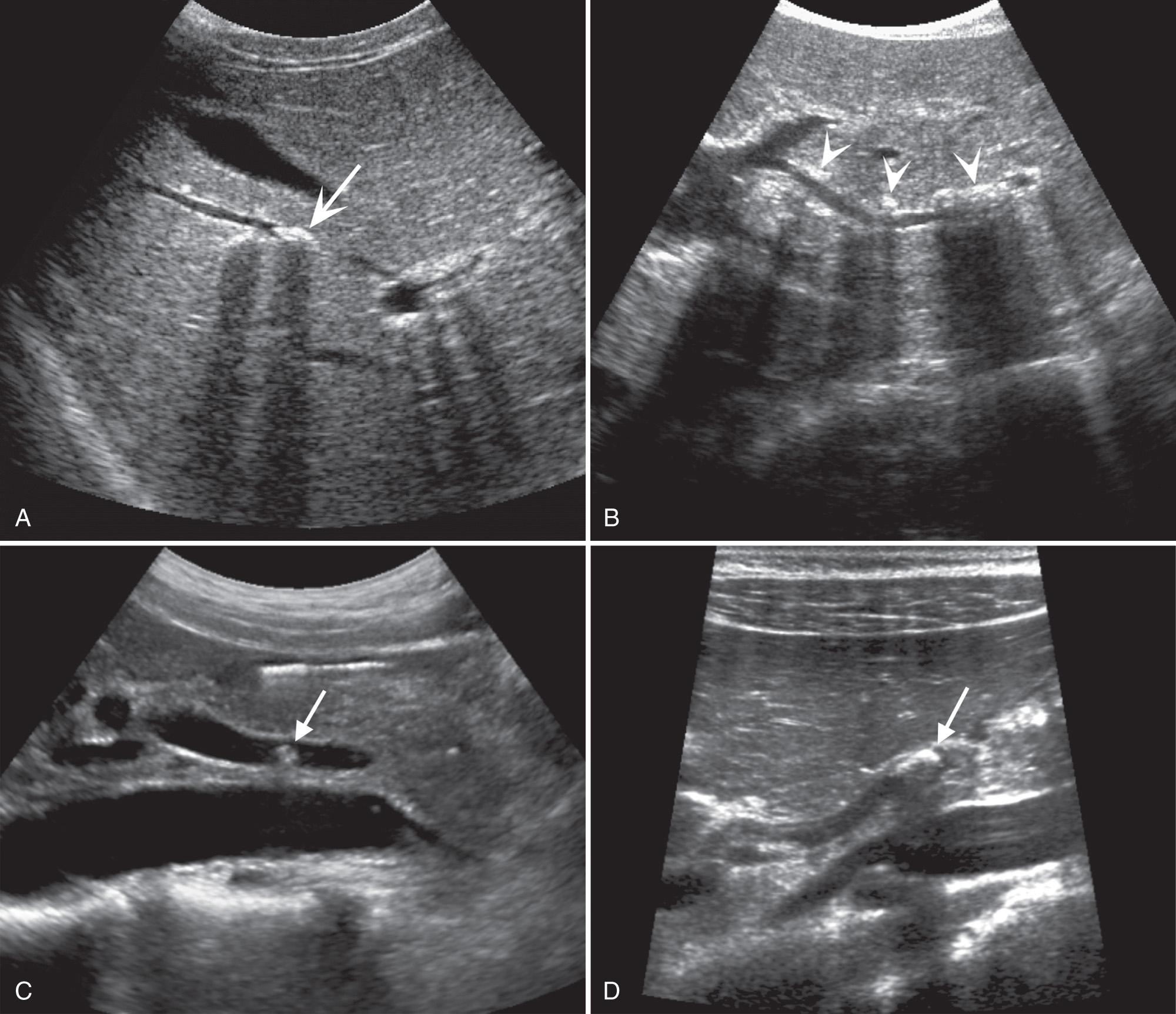
The majority of stones in the CBD are in the distal duct close to or at the ampulla of Vater. Therefore sonographic evaluation should include assessment of the entire duct, focusing on the periampullary region. Unfortunately, this region is often the most difficult area to visualize because it may be hidden by bowel gas, making detection of distal CBD stones difficult. Maneuvers to improve assessment include the following:
Changes in patient position. The CBD may be examined in supine, left lateral decubitus, and standing positions. The change in the relative position of adjacent organs and bowel gas may allow improved visualization of the distal duct.
Choice of sonographic window. The subcostal view is most useful for the assessment of the porta hepatis and proximal CBD. An epigastric view is best for the distal CBD.
Use of compression sonography. Physically compressing the epigastrium may collapse the superficial bowel and displace the bowel gas that is blocking the view.
Detailed assessment of the distal CBD. The distal intrapancreatic CBD is often best visualized with the probe focused on the pancreatic head in the transverse plane. Once the dilated CBD is identified, a slight rocking of the transducer to just “peek” at the point of caliber change will often allow a glimpse of a stone impacted in the distal duct, which is otherwise hidden from sonographic view. Similarly, a sagittal view focused on the pancreatic head should show the dilated CBD on the dorsal aspect of the head. Again, slight manipulation of the transducer, focusing on the point of caliber change, is best to see a solitary stone impacted in the distal duct. If the gallbladder is distended, it may be used as an acoustic window through which the distal CBD and ampulla may be visible.
The classic appearance of CBD stones is a rounded echogenic lesion with posterior acoustic shadowing (see Fig. 6.10 , Video 6.3 ). Importantly, no fluid rim will be seen around an impacted distal CBD stone because it is compressed against the duct wall. The lateral margins of the stone are therefore not seen, decreasing the conspicuity of the stone, versus a stone seen in the gallbladder or proximal duct, where it is likely to be surrounded by bile. Small stones may lack good acoustic shadows and appear only as a reproducible bright, linear echogenicity, either straight or curved. Awareness of this subtle appearance of CBD stones definitely improves their detection.
Pitfalls in the diagnosis of choledocholithiasis include blood clot (hemobilia), papillary tumors, and occasionally biliary sludge; none of these will shadow. Surgical clips in the porta hepatis, mostly from previous cholecystectomy, appear as linear echogenic foci with shadowing. The short length, the relatively high degree of echogenicity, the lack of ductal dilation, and the absence of the gallbladder should allow differentiation of surgical clips from stones.
Mirizzi syndrome is a clinical syndrome of jaundice with pain and fever resulting from obstruction of the CHD caused by a stone impacted in the cystic duct. It occurs most often when the cystic duct and CHD run a parallel course. The stone is often impacted in the distal cystic duct, and the accompanying inflammation and edema result in the obstruction of the adjacent CHD. The obstruction of the cystic duct causes recurrent bouts of cholecystitis, and the impacted stone may erode into the CHD, resulting in a cholecystocholedochal fistula and biliary obstruction. Identification of the fistula complication (called Mirizzi type II ) is important because the treatment requires surgical repair of the fistula. Acute cholecystitis, cholangitis, and even pancreatitis may occur.
Mirizzi syndrome should be considered on sonography when biliary obstruction with dilation of the biliary ducts to the CHD level is seen with acute or chronic cholecystitis. Thus the gallbladder has features of acute cholecystitis but may or may not be distended. A stone impacted in the cystic duct with surrounding edema at the level of the obstruction is confirmatory ( Fig. 6.11 ).
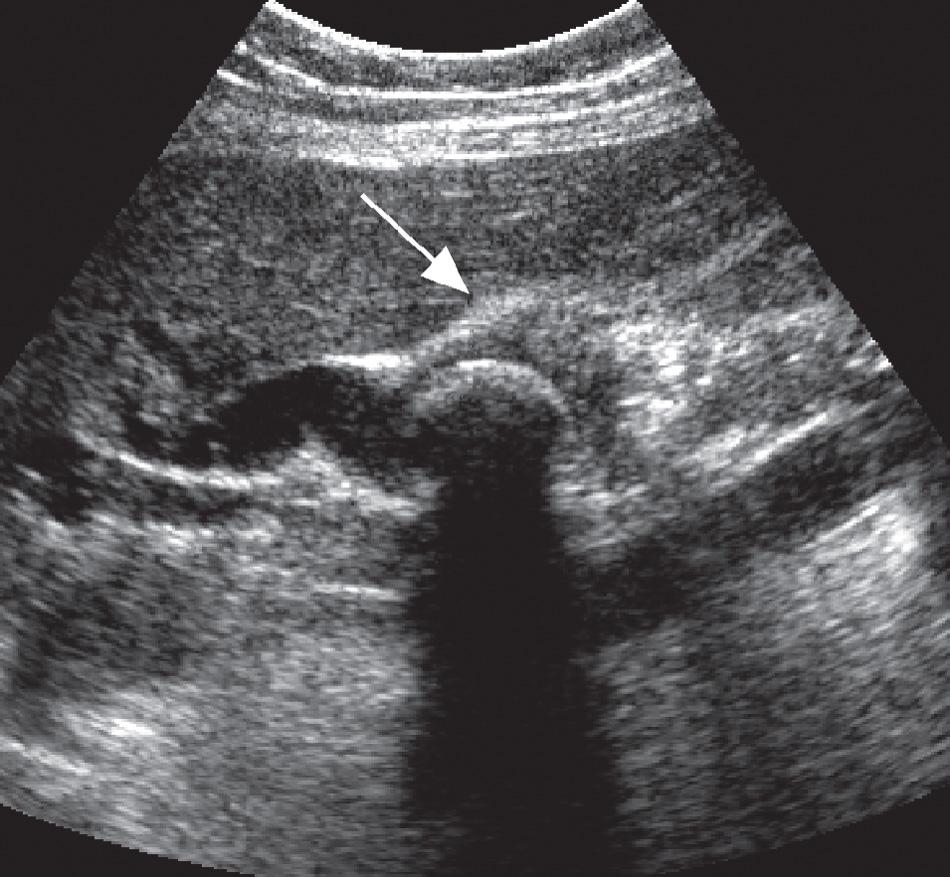
Iatrogenic biliary trauma, mostly caused by percutaneous biliary procedures or liver biopsies, accounts for approximately 65% of all causes of hemobilia. Other causes include cholangitis or cholecystitis (10%), vascular malformations or aneurysms (7%), abdominal trauma (6%), and malignancies, especially hepatocellular carcinoma and cholangiocarcinoma (7%). Pain, gastrointestinal bleeding, and biochemical jaundice are the usual complaints at presentation. Apart from the blood loss, which occasionally is severe, complications are rare and include cholecystitis, cholangitis, and pancreatitis.
The appearance of blood within the biliary tree is similar to blood clots encountered elsewhere ( Fig. 6.12 ). Most often, the clot is echogenic or of mixed echogenicity, and retractile, conforming to the shape of the duct. Occasionally, hemobilia may appear tubular with a central hypoechoic area. Acute hemorrhage will appear as fluid with low-level internal echoes. Blood clots may be mobile. Extension into the gallbladder is common. The clinical history is often essential to the diagnosis.
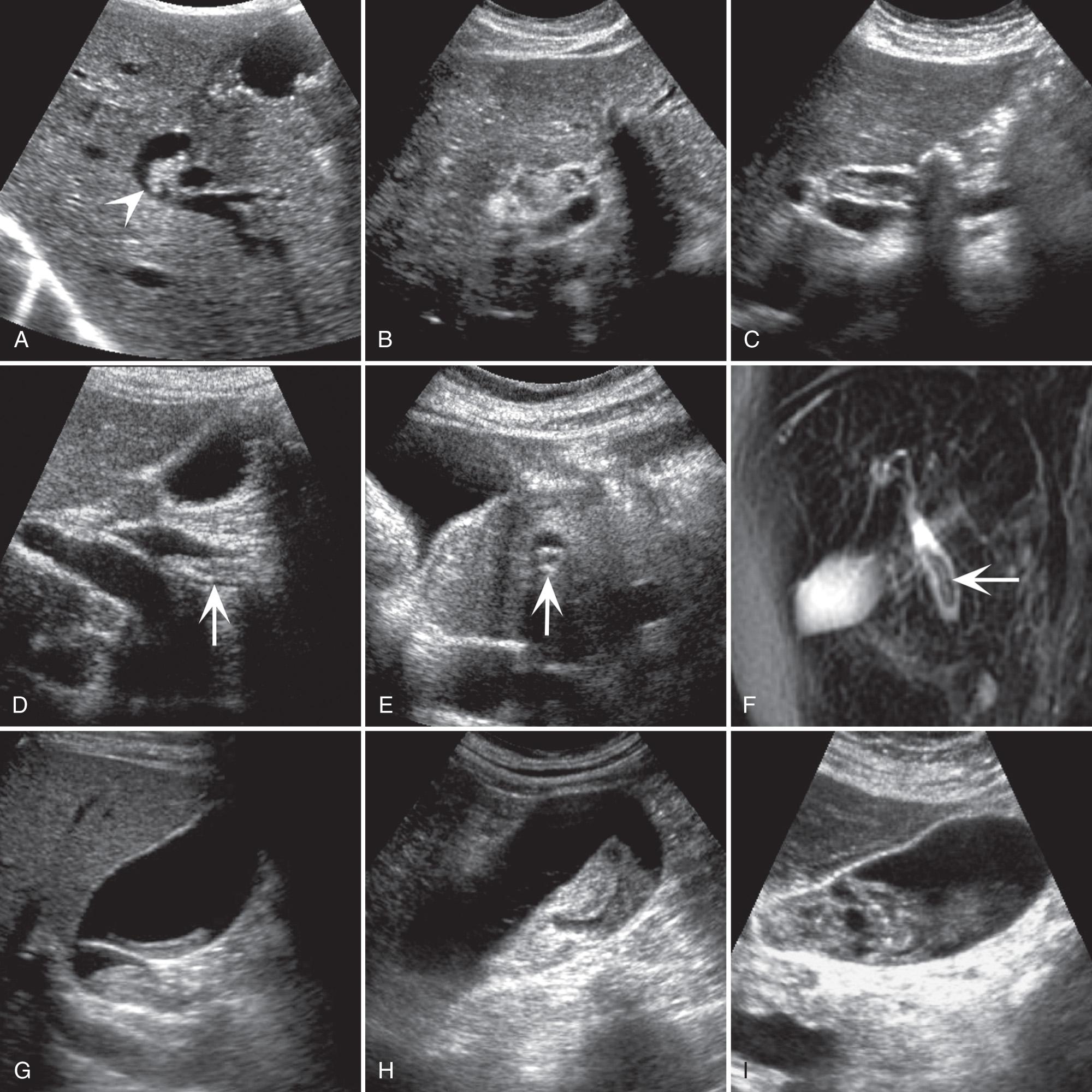
Air within the biliary tree usually results from previous biliary intervention, biliary-enteric anastomoses, or CBD stents. In the acute abdomen, pneumobilia may be caused primarily by three entities. Emphysematous cholecystitis may lead to pneumobilia; its risk factors and findings are discussed under “Acute Cholecystitis.” Inflammation caused by an impacted stone in the CBD may cause erosion of the duct wall, leading to choledochoduodenal fistula. The third entity, prolonged acute cholecystitis, may lead to erosion into an adjacent loop of bowel, most frequently the duodenum or transverse colon, called cholecystenteric fistula. Stones may then pass from the gallbladder into the bowel and can cause a gastric outlet or small bowel obstruction called gallstone ileus.
Air in the bile ducts has a characteristic appearance. Bright, echogenic linear structures following the portal triads are seen, more often in a nondependent position ( Fig. 6.13 ). Posterior “dirty” shadowing, reverberation, and ring-down artifacts are seen with large quantities of air. Movement of the air bubbles, best seen just after changing the patient's position, is diagnostic. Extensive arterial calcifications, seen especially in diabetic patients, can mimic pneumobilia.
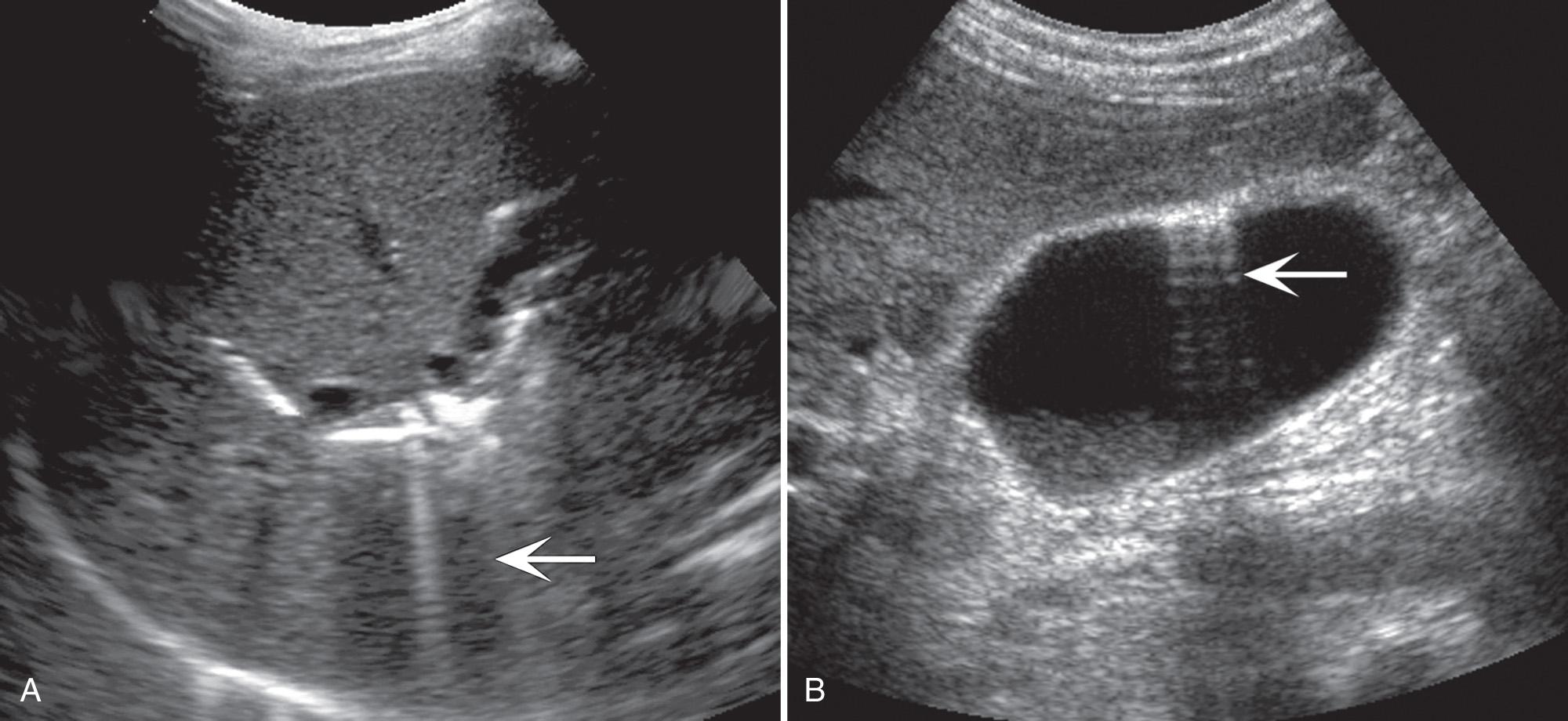
Antecedent biliary obstruction is an essential component of bacterial cholangitis, associated in 85% of cases with CBD stones. Other causes of obstruction include biliary stricture as a result of trauma or surgery, congenital abnormalities such as choledochal cysts, and partially obstructive tumors. Intrinsic or extrinsic neoplasms causing complete biliary obstruction rarely cause pyogenic cholangitis before biliary intervention. The clinical presentation is usually that of (1) fever (≈90%), (2) RUQ pain (≈70%), and (3) jaundice (≈60%), the classical Charcot triad. There is leukocytosis, or at least a left shift, and elevated levels of serum alkaline phosphatase and bilirubin in the great majority of patients. Often, mild serum hepatic transaminitis is present, but occasionally, levels above 1000 are seen early in the disease because of a sudden increase in intrabiliary pressures. The bile is most often infected by gram-negative enteric bacteria, which are often retrieved in blood cultures.
Acute cholangitis is a medical emergency. Sonography is advocated as the first imaging modality to determine the cause and level of obstruction and to exclude other diseases, such as cholecystitis, acute hepatitis, and Mirizzi syndrome. Sonography is more accurate than CT and more practical than MRI, endoscopic ultrasound, and ERCP in the initial assessment of patients with potential acute biliary disease.
The sonographic findings of bacterial cholangitis include the following ( Fig. 6.14 ):
Dilation of the biliary tree
Choledocholithiasis and possibly sludge
Bile duct wall thickening
Hepatic abscesses
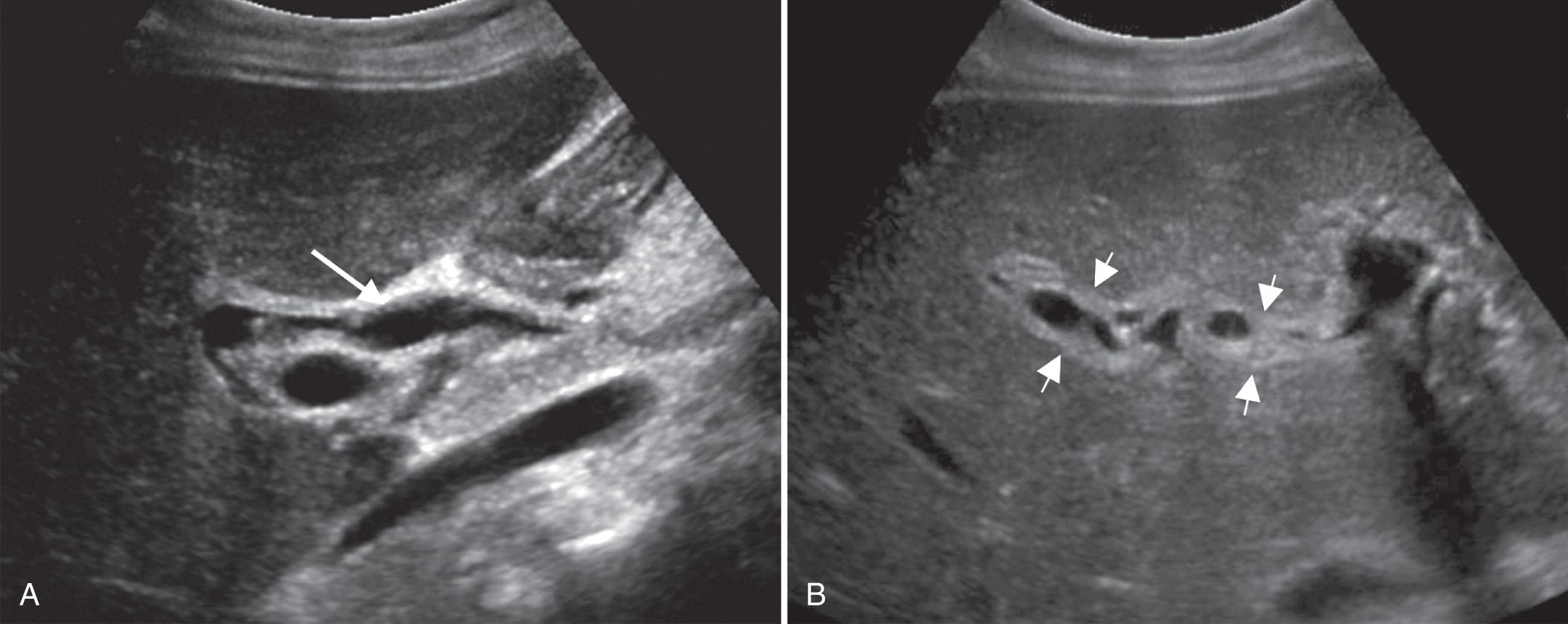
Dilation of the biliary tree, when present, can be diagnosed by sonography. A CBD diameter greater than 6 mm is considered abnormal in most patients. Subtle dilation of the intrahepatic biliary tree is a frequently overlooked finding that should be specifically sought. This includes use of subcostal oblique scanning of the porta hepatis to assess the caliber of the right and left hepatic ducts, as well as evaluation of the CBD, which may measure normal but still show a somewhat “tense” or distended morphology. Dilation of the biliary tree is seen in 75% of patients. The obstructive stone is usually lodged in the distal CBD but may be mobile, causing intermittent obstruction. Air is rarely seen within the ducts; thus its presence suggests a choledochoenteric fistula in the absence of previous biliary manipulation ( Fig. 6.15 , Video 6.4 ). Circumferential thickening of the bile duct wall, similar to other causes of cholangitis, may be present and may extend to the gallbladder. Multiple small hepatic abscesses—sometimes grouped in a lobe or segment of the liver—may be seen but tend to become visible on sonography when they have undergone liquefaction and are a late finding.
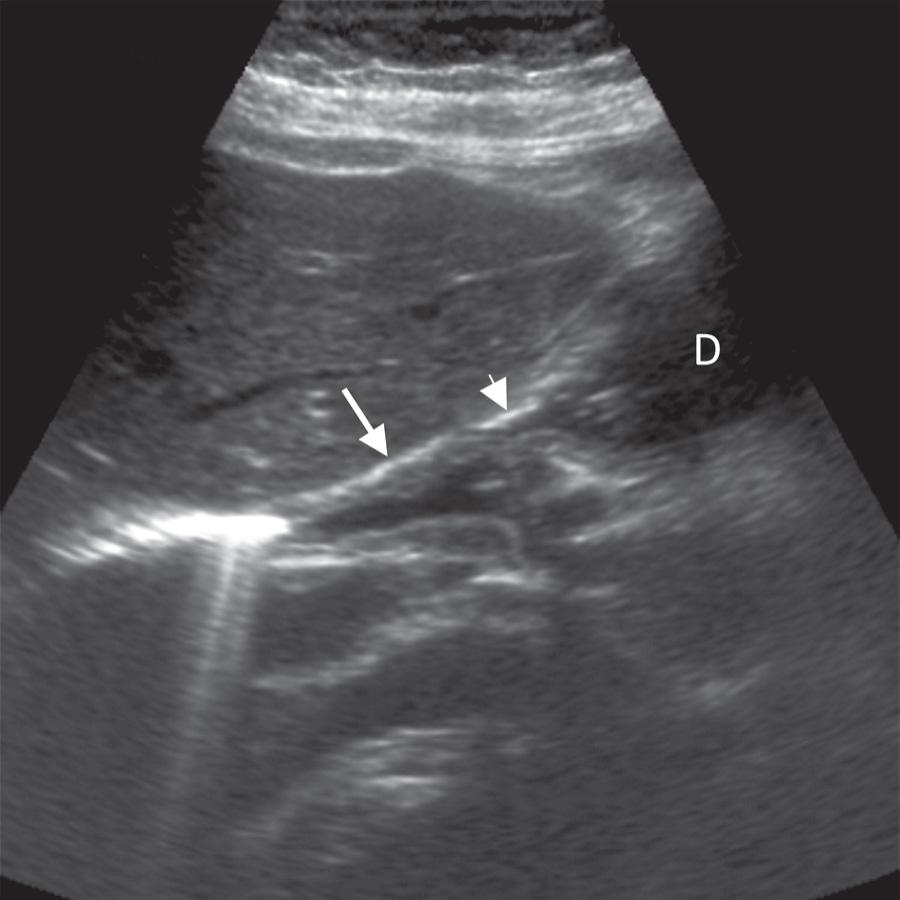
Fasciola hepatica infection is unevenly endemic in many regions of the world, including Asia, Europe, Northern Africa, and South America (mainly Peru and Bolivia). Infection is caused by consumption of water or raw vegetables contaminated with the larvae (metacercariae) of the F. hepatica fluke. The infection has two stages: the acute phase, lasting 3 to 5 months, and the chronic phase, which may last several years to over a decade. The acute phase corresponds to the migration of the immature larvae through the bowel wall, peritoneal cavity, and liver capsule, into the liver parenchyma. Patients may present with acute RUQ pain, hepatomegaly, and prolonged fevers. The final destination of the larvae is the biliary tree, where the parasite matures and produces eggs, indicating the chronic phase of infection. The mature Fasciola is the largest of the liver flukes (20-40 mm in length), is flat in shape (1 mm thin), and can be directly seen within the bile ducts. Symptoms then relate to biliary obstruction with intermittent jaundice, fevers, and intrahepatic abscesses. One-half of the patients are asymptomatic in the chronic phase.
The imaging appearance of fascioliasis depends on the phase of infection. In the acute phase, sonography demonstrates nonspecific findings of hepatomegaly, hilar adenopathy, and hypoechoic or mixed echogenicity lesions ( Fig. 6.16 ). The hepatic lesions are often multiple, confluent, subcapsular, and ill-defined and are present in approximately 90% of patients. The specific finding of the migratory tract of the larvae, manifest by small cystlike clusters in serpiginous tracts in the periphery of the liver are better imaged with CT or MRI. Serial examination may show slowly evolving disease with progressive central migration of lesions and periportal tracking representing lymphangiectasia in the portal triads. Sonography is more specific in the chronic ductal phase of the disease, depicting ductal dilation and the flukes in the ducts and gallbladder as flat, sometimes moving, material ( Fig. 6.17 ). However, the most common findings are gallbladder and bile duct wall thickening. The living flukes within the gallbladder were present in 37% of patients in a series of 87 patients.
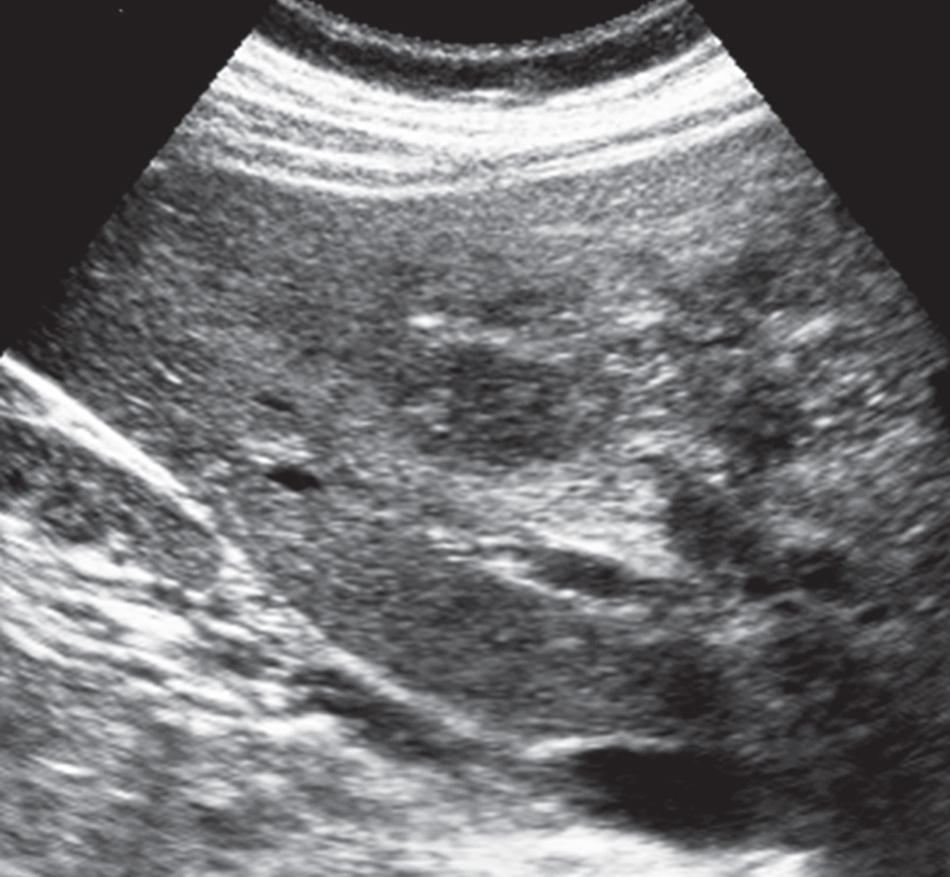
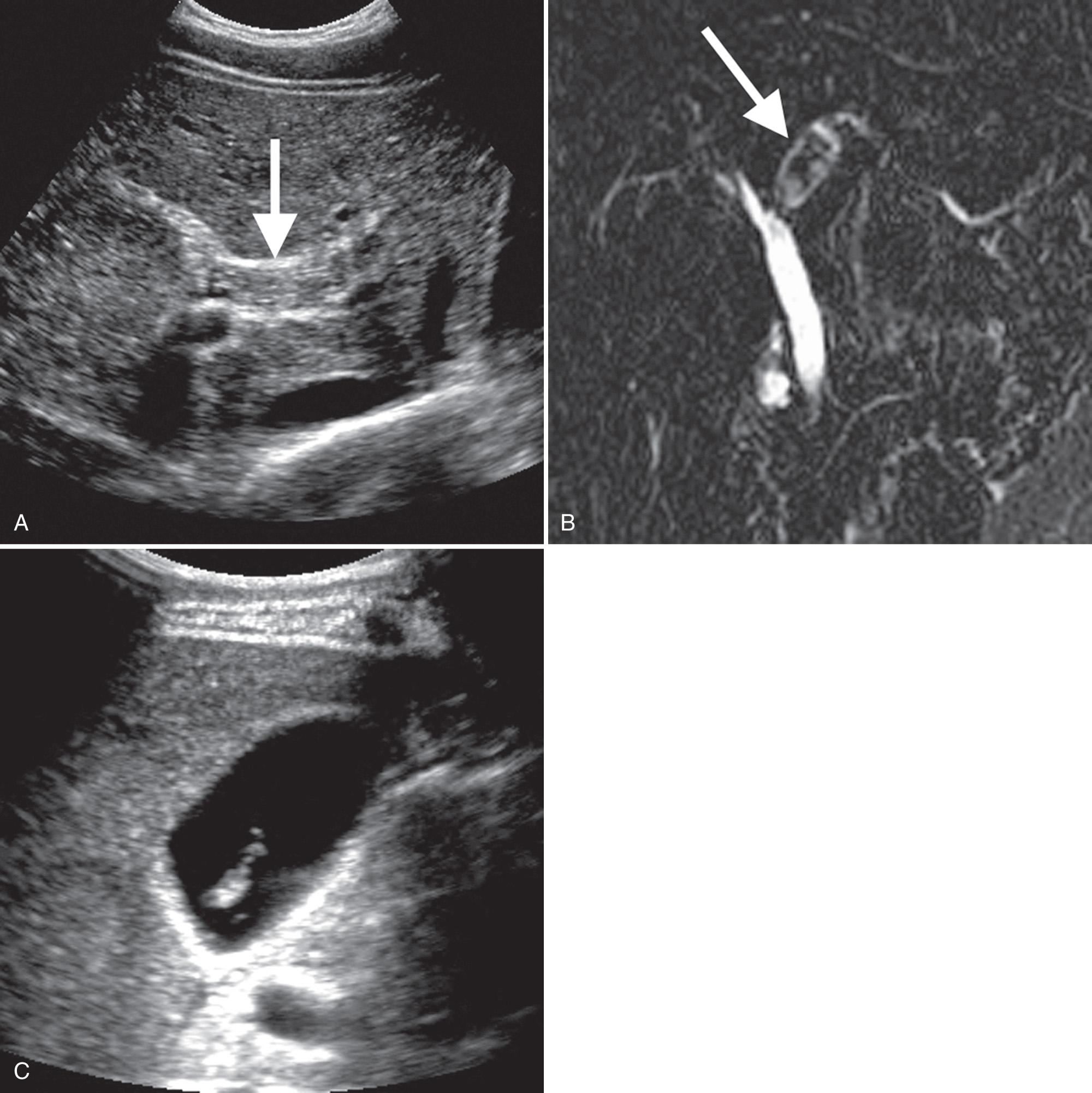
Become a Clinical Tree membership for Full access and enjoy Unlimited articles
If you are a member. Log in here